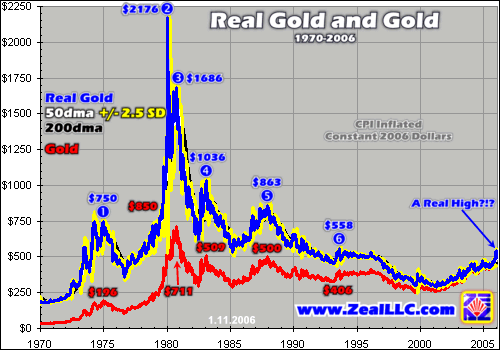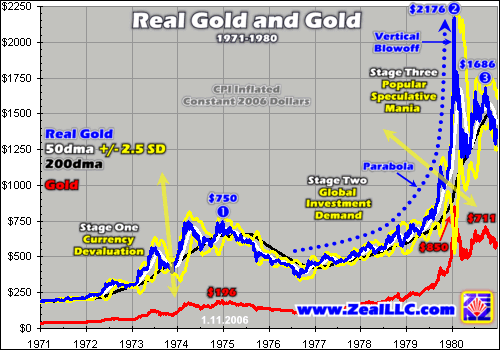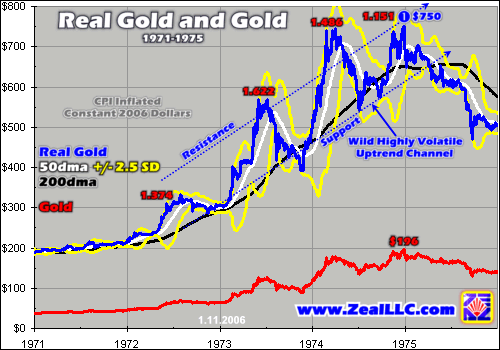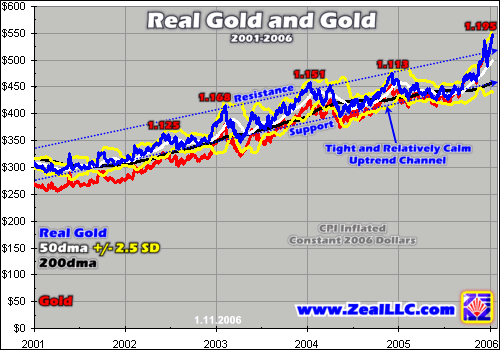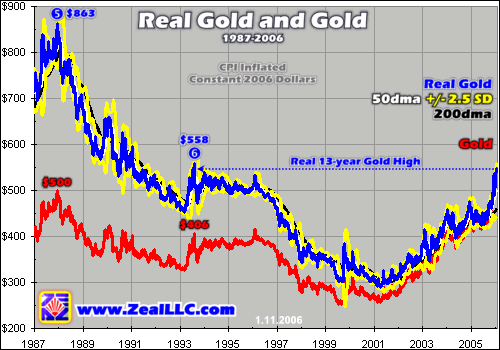|
|
|||||||
|
|
|
|
|
|
|
|
|
|
Real Gold Highs? Adam Hamilton January 13, 2006 3446 Words
The Ancient Metal of Kings continued to dazzle this week, challenging $550. In honor of this awesome event, headlines in the financial press trumpeted gold’s 25-year highs. While technically correct, indeed gold did last close over $550 a quarter century ago to the month in January 1981, the media’s fixation on today’s gold highs is quite misleading.
Prudent investors, and rightfully so, tend to be wary when they hear of prices trading near 25-year highs. The core tenet of successful investing is to buy low and sell high. So if an asset is trading at a quarter-century high-water mark then odds are its price is pretty darned high at the moment and therefore a bad buy, right?
If I was not a student of the markets and hadn’t spent years studying gold, I know I would be reluctant to invest in anything near a 25-year high. Buying high is anathema to the whole contrarian investment philosophy of buying cheap and selling dear. But gold, believe it or not, is still a great contrarian investment even at today’s quarter-century nominal highs.
How is this seemingly absurd thesis possible? The answer is the measuring stick for any investment pricing, the US dollar, has radically changed in the last several decades. A dollar today is worth vastly less than a dollar was 25 years ago, the last time gold closed over $550. Comparing nominal dollar prices of decades past with dollar prices of today is not valid, a horribly flawed apples-to-oranges kind of thing.
Do you remember prices in the early 1980s? They were almost trivial compared to what we face today. The median home price in the US was $76k. You can hardly even buy an empty lot in suburbia for this today, let alone a house. The median American income was under $18k. Today $18k is actually below the official US poverty line for a family of four! A first-class postage stamp ran 15˘. The average new car was about $7k.
So a quarter century ago the $550 it cost to buy an ounce of gold went a heck of lot farther in terms of buying real goods and services than it would today. This is, of course, due to the inflation of the number of dollars in circulation. The US government via the Federal Reserve relentlessly prints money and as this new money created out of thin air filters into the US economy it directly competes for limited goods and services and bids up their prices.
I have written a lot about real-world examples of inflation in the past if you would like some background. These include John Law’s notorious 18th-century inflation in France, the North Slope oil boom in Alaska, and even virtual inflation in the online computer games so popular today. Anytime the money supply of a particular era or place grows faster than the supply of goods and services on which to spend it, general prices are inevitably driven relentlessly higher. This financial law is as immutable as gravity.
Since 1981 dollars were so different from today’s in terms of purchasing power due to the US inflation since, it makes no sense at all to compare those dollars with today’s dollars straight up. The more I study the financial markets, the more I am convinced that looking at any price chart running for more than a decade or so without considering the impact of inflation is horribly distorting and leads to poor decision making. Incidentally this applies to the general stock markets too.
While I have been writing about inflation-adjusted, or real, gold and oil since June 2000, those comparisons modeled monthly data. The most widely accepted measure of US inflation, the Consumer Price Index, is published once a month so most inflation analysis also uses monthly data. But the problem with monthly financial data is it clips off most of the major closing highs and lows that the media use to proclaim XX-year milestones.
In this new series of essays, which will grow more important as gold approaches its 1980 all-time non-inflation-adjusted, or nominal, highs of $850, I am using daily gold data for much higher resolution. The financial media and Wall Street, which have never liked commodities, are going to be working overtime to falsely convince people that gold is expensive today in order to dissuade them from multiplying their capital in this bull. They don’t like to see capital diverted from general stocks into commodities.
I built a nearly 10k-row spreadsheet that melded the monthly CPI inflation data with the daily gold data to create a CPI-inflated real gold data series running back before 1970. While I am a long-time opponent of the horribly manipulated CPI since it lowballs inflation, I used it here because it is conservative and widely accepted as authoritative. While real gold would be considerably higher when using MZM or M3 money supplies as an inflation proxy, this essay would not be as credible with mainstreamers if I went that route.
So is gold really at a breathtaking 25-year high once the radically changing measuring stick of the US dollar is considered? Not even close! So far in real terms gold has barely clawed back above where it languished for years in the mid-1990s. The recent real-gold prices still look dirt cheap compared to average gold prices of the last 35 years or so. Investors can still buy low today!
Gold last closed above $550 nominal on January 23rd, 1981, almost 25 years ago to the week. Yet adjusted for inflation an ounce of gold was really worth $1266 that day in purchasing-power terms. Thus in order to truly see the quarter-century gold highs that the financial media is wailing about, gold in today’s dollars would have to head north of $1250. 25-year gold highs today my foot!
Anyone who thinks comparing nominal numbers across 25 years is acceptable ought to give 4/7ths of their gross income to charity and live off the remaining 3/7ths. Such a 56% cut in pay today would create the equivalent of living in an expensive 2006 world with early 1980s nominal salary levels. The average cost of living as measured by the lowballed CPI is up 2.29x since then and today’s dollar is worth at least that much less.
This long-term real gold chart helps put our current gold bull into proper perspective. Sound perspective is crucial in investing. If you gain the proper perspective before you deploy your capital it vastly improves your odds of making wise decisions and multiplying your fortune. But if you invest without a proper perspective the battle is probably lost before it even starts. One cannot buy low and sell high if their perspective is distorted!
The young gold bull of the last five years that looks so impressive on nominal charts is just barely starting to get interesting in real terms in the last several months. From the mid-1970s until the mid-1990s gold rarely went below $500 in today’s dollars so $500 gold really is historically cheap. Today gold would have to challenge $1000 before it started getting expensive and it would have to rocket up near $2200 to hit all-time real highs.
Gold, of course, is a competing currency with the US dollar. When it is considered in these terms, gold could even be far cheaper today than the CPI-inflated chart above indicates. Since the early 1980s governments worldwide have grown their fiat currencies by rates averaging around 7% a year. But over this same period of time the global gold supply has only grown about 1% a year. It’s actually this slow natural growth rate, or low inflation rate, due to the extreme difficulty in mining gold that has made it the world’s premier currency for six millennia.
Assuming these growth rates are roughly correct, and compounding them for the 25 years since 1980, the world’s money supply has ballooned by 5.4x. Meanwhile the global gold supply is only up 1.3x. Dividing these 25-year growth estimates yields a ratio of global-fiat-currency-supplies-to-gold-supplies of about 4.2x. Now there is 4x as much fiat paper floating around relative to gold as there was in 1980! The $850 spike high in January 1980 multiplied by this ratio yields an all-time gold high of $3570 in today’s dollars.
I offer up this rough example to illustrate that gold is becoming more and more dear relative to the reams of fiat currencies in circulation all over the world today. If a similar fraction of investors starts bidding on gold again at some point that was bidding it up three decades ago, we could see a euphoria spike high ultimately far exceeding even the $2200 CPI-adjusted high charted above. Gold is radically undervalued relative to fiat currencies and a lot more fiat exists that can bid on it now than 25 years ago.
With my core thesis that gold is cheap today in real terms explained, now we can branch out into some other interesting sub-views of this fascinating dataset. In order to aid this comparison, we marked six of the greatest secular gold highs in recent decades on the chart above and labeled their nominal and real levels. These labels carry into the subsequent four charts that examine different sub-sections of this real gold data.
The last great gold bull, in the 1970s, is really illuminating when viewed through the lens of today’s dollars. While our current bull won’t unfold in exactly the same way, this real view of history helps to properly set our expectations on the rough magnitude of gold moves we might expect this time around.
Now this is a Great Gold Bull, feast your eyes! Gold went up about 11x in real terms in the 1970s, from $200 in today’s dollars to nearly $2200 in today’s dollars! Over this period of time this gold bull went through three distinct stages just as ours is likely to do today. They are initially driven by currency devaluation, then surging global investment demand, and finally a popular speculative mania.
Back in the early 1970s Stage One ended near $500 or so in today’s dollars, incidentally the same real levels that are triggering our transition into Stage Two today. Once investment demand started kicking in gold surged higher to $750 real initially but then ground back down under $500 real in the next couple years before reasserting itself. Ultimately Stage Two drove gold above $1000 real before the general public got involved.
Now Stage Two in the 1970s was not much fun between 1975 and 1977 when gold gradually slumped and then recovered. Quite a few folks have asked me whether we could be in for another major mid-bull multi-year correction in gold again this time around. While I freely acknowledge that it could happen again since anything is possible in the markets, I don’t think it is likely. Today’s investment scene is so vastly different from the mid-1970s.
Believe it or not, our wonderfully benevolent dictatorship in Washington actually made gold bullion illegal for US citizens to own from 1933 to 1974! Washington finally restored our right to own gold, which is Constitutional money, back on December 31st, 1974. So when Stage Two kicked in during the mid-1970s Americans were largely not involved on the buy side initially.
After 41 years of gold bullion being considered an Enemy of the State there was not really a ready market for it as an investment. And it wasn’t particularly easy to buy immediately after that either. At the time coin stores specialized in rare gold coins, which generally weren’t declared illegal by Franklin Delano Roosevelt. It wasn’t easy to buy the bullion coins without premiums so popular today. And investors had to go through the trouble of opening a futures account to trade gold, and market information didn’t flow as well back then.
Today’s gold bull is in a drastically different environment, the Information Age. American contrarian investors have been buying and selling gold for three decades and are very comfortable doing it. Coin stores are now everywhere and buying gold bullion coins today is as easy as buying groceries. Stock traders can now even trade gold ETFs from within their stock accounts, bidding up gold without even having to mess with futures. And information flows fast today.
This instant information flow is probably the greatest factor in why a multi-year slump is unlikely in today’s bull. Investors today chase performance, and relative to past generations we seem to have more information at our fingertips today thanks to the Internet than even the masters of the investing universe had decades ago. The higher the gold price runs today, the more it is reported on and the more investors grow interested. They then chase this bull, throwing in their capital which drives it up even higher creating a virtuous circle of demand.
At some point all this awareness spills outside of contrarians, outside of mainstreamers, and a powerful gold lust takes root in the general public. This is when Stage Three dawns. The final stage of a secular bull is the vertical blowoff mania when the public rushes in to get a piece of the action. Frenzied public buying pushes prices stratospheric, often doubling in about a year. Just as the NASDAQ doubled in its final year before its early 2000 crash, gold also doubled from $1100 real to $2200 real leading into early 1980.
This parabolic spike driven by a popular mania is the signal that a bull is over. When you see gold prices double in a year, when you hear hot tips about gold stocks at cocktail parties, when all the financial media ever seems to talk about is the commodities bull, this is the time to get out. Vertical moves higher on long-term charts are never sustainable and always precede crashes.
Has gold gone vertical today? Has it doubled in the past year? Not even close! There is no rush like a gold rush and believe me you will absolutely know it when the next one arrives. Stage Three is phenomenally lucrative and we are not even close yet this time around. The total lack of blowoff in today’s gold market when charted on a decade chart is further evidence that gold is cheap today, not dear.
Our next chart looks at the early years of the 1970s gold bull in this real-gold dataset. It helps illustrate the raw magnitude of gold moves that are possible in today’s dollars as we continue to transition into Stage Two.
In the early 1970s gold in 2006 dollars was trading near $200, which is remarkably close to the $290ish real levels from which our current gold bull launched back in April 2001. Gold then went on to carve a wild and highly volatile uptrend channel with huge swings in both directions. In particular from late 1973 to early 1974 gold soared from $400 real to over $700 real. This upleg is fascinating because it marked the beginning of Stage Two.
Today we are also transitioning into Stage Two once again, and gold’s latest run started near $425 real back in July. Near $550 today some think this latest 29% upleg is ridiculously large. But if today’s gold upleg managed to march up a similar percentage to the first Stage Two upleg of the 1970s, we would be looking at the next major interim top near $750 again. While I don’t suspect today’s upleg will hit such lofty levels before correcting, this real gold data just shows what is possible and expands our expectation horizons.
Really though, the character and volatility signature of the early 1970s bull is much different from today’s. The red numbers near each interim gold high above are real rGold numbers, real gold divided by its 200-day moving average. As gold surged above its 200dma in new uplegs it stretched wildly higher at times, up to 62% over its 200dma. By comparison our current gold bull has yet to even exceed 20% over its 200dma in real terms.
Today’s gold bull, also shown on a zeroed chart to highlight the immense difference in volatility, has been far more sedate. Gold’s uptrend channel this time around is tight and relatively calm. This far more modest volatility signature will probably work out to our advantage though. With gold advancing in a very orderly fashion this time around, odds are it won’t advance so fast that it needs a multi-year correction like the mid-1970s to bleed off mid-bull speculative excesses.
Gold is probably less volatile today for a variety of reasons. The gold market is far broader and deeper today with many more investors and participants than in the 1970s. More speculators actively betting against each other leads to more accurate pricing with fewer wild anomalies. The less high gold gets stretched over its 200dma in its uplegs prior to its periodic and healthy corrections, the shorter these corrections need to be to restore sentiment balance.
And unlike the 1970s when some major currencies were severing ties to gold and creating huge market distortions, today no paper currency on the planet is backed by gold. Thus governments, while they are still active in gold to some extent, have nowhere near as big of footprint relative to the total market as they did in the 1970s. Few other entities are able to buy or sell gold at government scales, thus moderating volatility today.
Information flow is probably a factor here as well. Investors today can react far more rapidly to a surge or slump in gold and enter their trading orders instantly online without having to go through the cumbersome futures machinery for trading. These quicker reactions to developments tend to moderate both the upside potential of uplegs and downside potential of corrections and reduce systemic volatility.
Our final real gold chart zooms in to the past decade. Quarter-century gold highs today? Not if one is honest and considers the relentlessly eroding purchasing power of the fiat US dollar.
This week gold hit its highest level in real terms since August 1993, roughly 13-year highs. Now a 13-year high is exciting and certainly nothing to sneeze at, but it is a far cry from a 25-year high. When you think about gold today being at about the same levels it was at in the mid-1990s, which was near the tail end of a multi-decade bear market, it creates an entirely different perspective of gold’s relative cheapness or dearness today.
The financial media shrilly trumpeting quarter-century nominal highs as if gold is on the verge of a massive secular crash is incredibly naďve. Investors who are swayed by these poor arguments risk missing the next two-thirds, indeed the biggest two-thirds, of our current gold bull. Making multi-decade price comparisons casually without considering the impact of inflation is terribly flawed and leads to an extremely distorted perception of market realities.
Yes gold will inevitably get temporarily overbought and will crest at its next major interim high here sooner or later and then correct back down to its 200dma as it has done many times before in this bull market. But gold is not yet anywhere close to being expensive in the long secular terms that really matter for investors. At Zeal we will continue speculating on individual gold uplegs as we have done for this entire bull, but I want to make sure investors understand that gold is not high today by historic standards.
If you are a speculator or your gold investments extend into gold stocks, you ought to subscribe to our acclaimed monthly newsletter where we time gold’s big swings and recommend elite leveraged gold stocks when appropriate. As of this week our current gold-stock trades, recommended between June and August of 2005 as this latest upleg started surging, are up an average of 73%. Please subscribe today so you don’t miss the next awesome buying opportunity after gold corrects!
The bottom line is gold is nowhere close to being expensive yet relative to history in the real terms that matter. This new bull market in gold will probably not give up its ghost until it approaches historical real extremes well above $1000 in today’s dollars. While gold will flow and ebb within this bull, the entire secular uptrend itself is not in danger as long as gold remains relatively inexpensive within the context of modern history.
It is not prudent or valid to compare today’s dollars to dollars of decades past without adjusting for inflation. Whenever the financial media insists on doing this it is lazy at best and intentionally trying to mislead investors at worst. We won’t really see 25-year gold highs until the metal exceeds $1250!
Adam Hamilton, CPA January 13, 2006 Subscribe |
|||||||
|
|
|
|
|
|
|
|
|
|
|
|
|
|
|
|||

